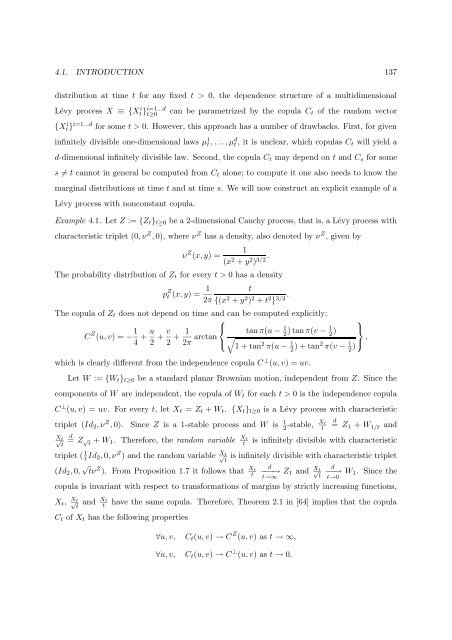Processus de Lévy en Finance - Laboratoire de Probabilités et ...
Processus de Lévy en Finance - Laboratoire de Probabilités et ...
Processus de Lévy en Finance - Laboratoire de Probabilités et ...
You also want an ePaper? Increase the reach of your titles
YUMPU automatically turns print PDFs into web optimized ePapers that Google loves.
4.1. INTRODUCTION 137<br />
distribution at time t for any fixed t > 0, the <strong>de</strong>p<strong>en</strong><strong>de</strong>nce structure of a multidim<strong>en</strong>sional<br />
Lévy process X ≡ {X i t} i=1...d<br />
t≥0<br />
can be param<strong>et</strong>rized by the copula C t of the random vector<br />
{X i t} i=1...d for some t > 0. However, this approach has a number of drawbacks. First, for giv<strong>en</strong><br />
infinitely divisible one-dim<strong>en</strong>sional laws µ 1 t , . . . , µ d t , it is unclear, which copulas C t will yield a<br />
d-dim<strong>en</strong>sional infinitely divisible law. Second, the copula C t may <strong>de</strong>p<strong>en</strong>d on t and C s for some<br />
s ≠ t cannot in g<strong>en</strong>eral be computed from C t alone; to compute it one also needs to know the<br />
marginal distributions at time t and at time s. We will now construct an explicit example of a<br />
Lévy process with nonconstant copula.<br />
Example 4.1. L<strong>et</strong> Z := {Z t } t≥0 be a 2-dim<strong>en</strong>sional Cauchy process, that is, a Lévy process with<br />
characteristic tripl<strong>et</strong> (0, ν Z , 0), where ν Z has a <strong>de</strong>nsity, also <strong>de</strong>noted by ν Z , giv<strong>en</strong> by<br />
ν Z (x, y) =<br />
1<br />
(x 2 + y 2 ) 3/2 .<br />
The probability distribution of Z t for every t > 0 has a <strong>de</strong>nsity<br />
p Z t (x, y) = 1 t<br />
2π {(x 2 + y 2 ) 2 + t 2 } 3/2 .<br />
The copula of Z t does not <strong>de</strong>p<strong>en</strong>d on time and can be computed explicitly:<br />
⎧ ⎫<br />
C Z (u, v) = − 1 4 + u 2 + v 2 + 1 ⎨<br />
2π arctan tan π(u − 1 2 ) tan π(v − 1 2 ) ⎬<br />
⎩<br />
√1 + tan 2 π(u − 1 2 ) + tan2 π(v − 1 2 ) ⎭ ,<br />
which is clearly differ<strong>en</strong>t from the in<strong>de</strong>p<strong>en</strong><strong>de</strong>nce copula C ⊥ (u, v) = uv.<br />
L<strong>et</strong> W := {W t } t≥0 be a standard planar Brownian motion, in<strong>de</strong>p<strong>en</strong><strong>de</strong>nt from Z. Since the<br />
compon<strong>en</strong>ts of W are in<strong>de</strong>p<strong>en</strong><strong>de</strong>nt, the copula of W t for each t > 0 is the in<strong>de</strong>p<strong>en</strong><strong>de</strong>nce copula<br />
C ⊥ (u, v) = uv. For every t, l<strong>et</strong> X t = Z t + W t . {X t } t≥0 is a Lévy process with characteristic<br />
tripl<strong>et</strong> (Id 2 , ν Z , 0).<br />
X t √t<br />
Since Z is a 1-stable process and W is 1 2 -stable, X t<br />
t<br />
d = Z √<br />
t<br />
+ W 1 . Therefore, the random variable Xt<br />
t<br />
d<br />
= Z 1 + W 1/t and<br />
is infinitely divisible with characteristic<br />
tripl<strong>et</strong> ( 1 t Id 2, 0, ν Z ) and the random variable Xt √<br />
t<br />
is infinitely divisible with characteristic tripl<strong>et</strong><br />
(Id 2 , 0, √ tν Z ). From Proposition 1.7 it follows that Xt d<br />
t<br />
−−−→ Z 1 and Xt d<br />
√<br />
t→∞<br />
t<br />
−−→ W 1 . Since the<br />
t→0<br />
copula is invariant with respect to transformations of margins by strictly increasing functions,<br />
X t , Xt √<br />
t<br />
and Xt<br />
t<br />
have the same copula. Therefore, Theorem 2.1 in [64] implies that the copula<br />
C t of X t has the following properties<br />
∀u, v, C t (u, v) → C Z (u, v) as t → ∞,<br />
∀u, v, C t (u, v) → C ⊥ (u, v) as t → 0.
















